Financial Accounting: Stakeholders, Transactions, and Statements
VerifiedAdded on 2020/10/04
|26
|3644
|144
Report
AI Summary
This financial accounting report provides a comprehensive overview of financial accounting principles and practices. It begins with an introduction to financial accounting, its purpose, and the identification of internal and external stakeholders, along with their respective interests in financial information. The report then delves into specific client scenarios, including journal entries, profit and loss accounts, balance sheets, and explanations of key accounting concepts such as going concern, accrual, consistency, and prudence. The purpose of depreciation in accounting statements is explained, along with the differences in financial statements prepared by sole traders and limited companies. Furthermore, the report covers bank reconciliation statements, imprest systems, and control accounts. It concludes with an analysis of suspense accounts and trial balances, and the importance of journal entries and corrections. The report uses examples from the small business accounting firm, Brookscity, to illustrate the practical application of these concepts. Overall, the report provides a detailed analysis of financial accounting principles and their application in various business contexts.
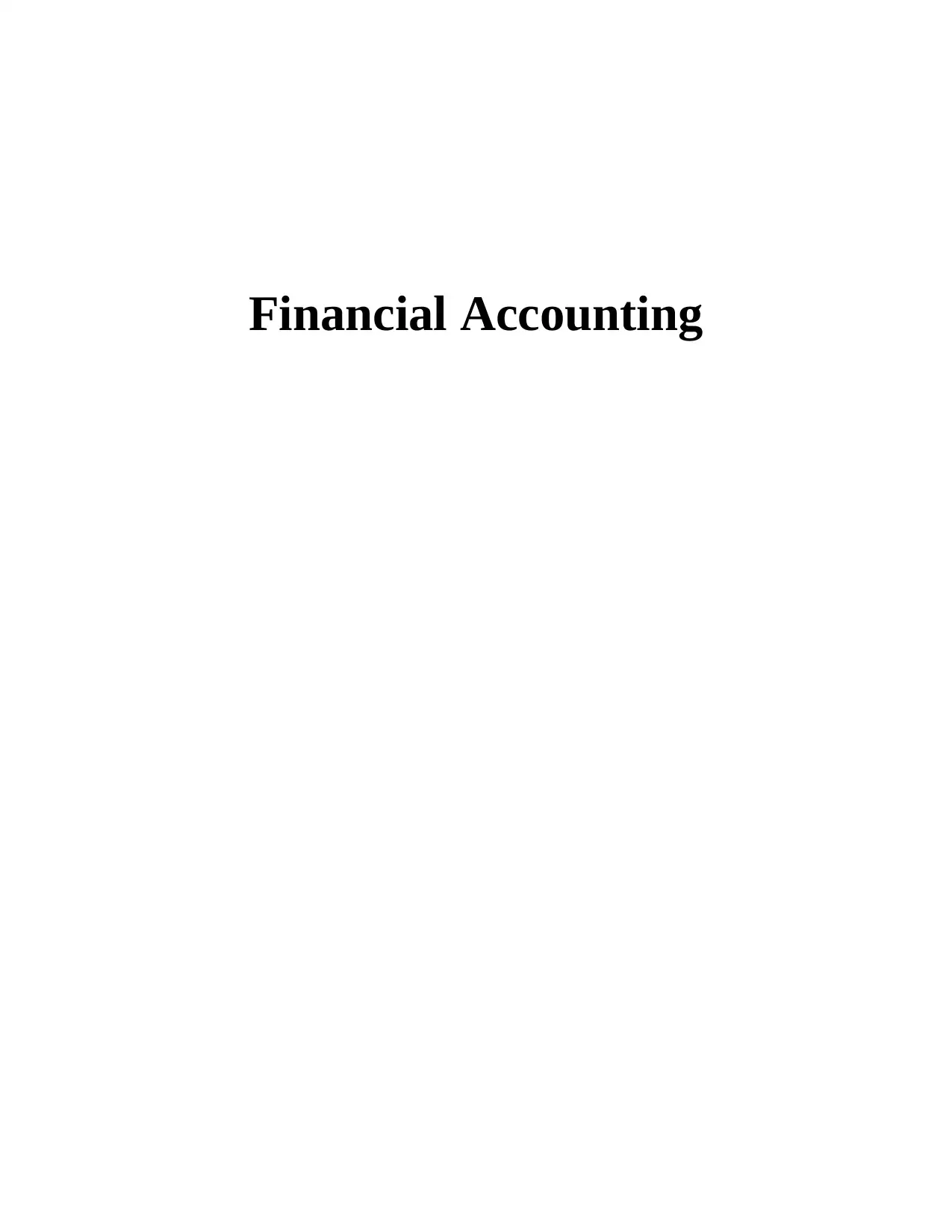
Financial Accounting
Paraphrase This Document
Need a fresh take? Get an instant paraphrase of this document with our AI Paraphraser
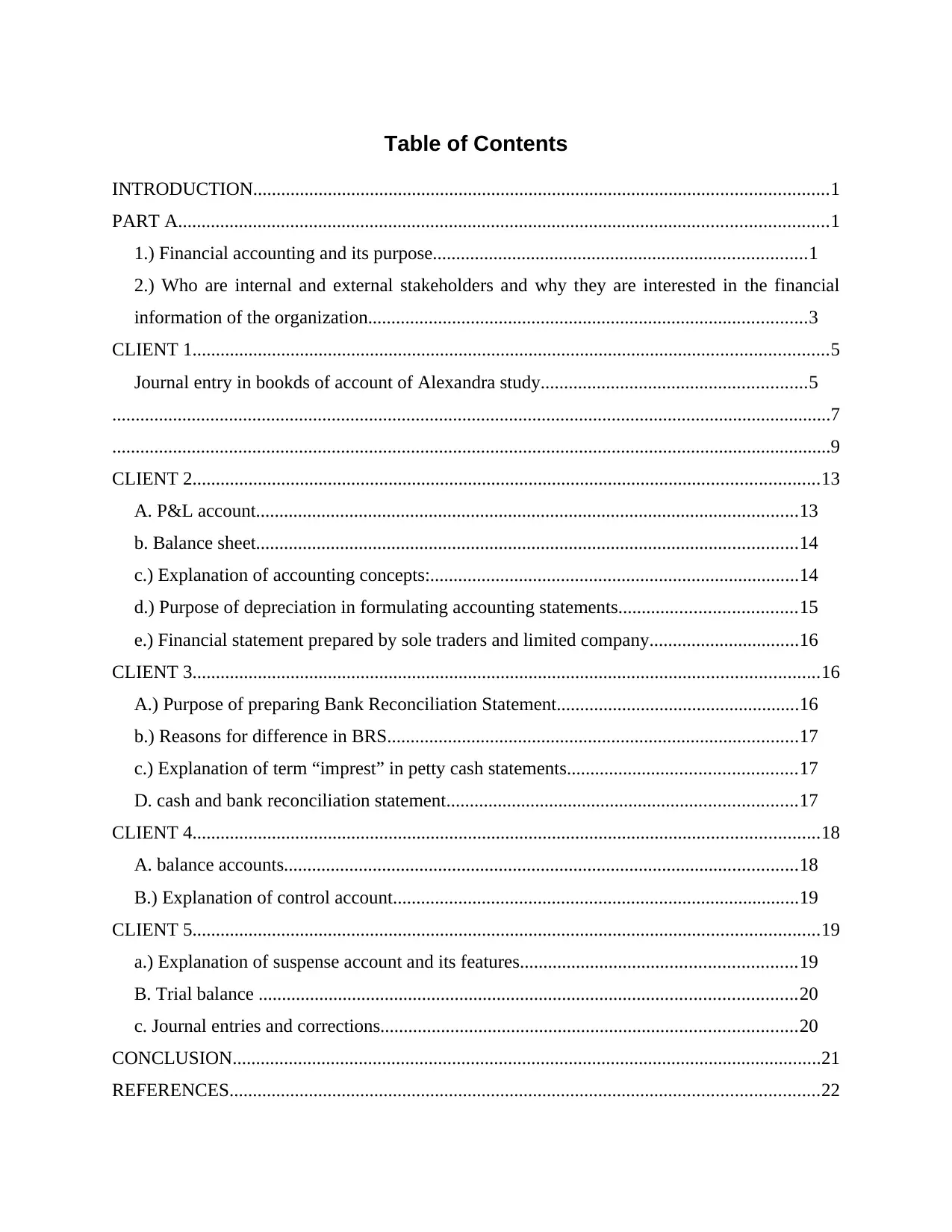
Table of Contents
INTRODUCTION...........................................................................................................................1
PART A...........................................................................................................................................1
1.) Financial accounting and its purpose................................................................................1
2.) Who are internal and external stakeholders and why they are interested in the financial
information of the organization..............................................................................................3
CLIENT 1........................................................................................................................................5
Journal entry in bookds of account of Alexandra study.........................................................5
..........................................................................................................................................................7
..........................................................................................................................................................9
CLIENT 2......................................................................................................................................13
A. P&L account....................................................................................................................13
b. Balance sheet....................................................................................................................14
c.) Explanation of accounting concepts:...............................................................................14
d.) Purpose of depreciation in formulating accounting statements......................................15
e.) Financial statement prepared by sole traders and limited company................................16
CLIENT 3......................................................................................................................................16
A.) Purpose of preparing Bank Reconciliation Statement....................................................16
b.) Reasons for difference in BRS........................................................................................17
c.) Explanation of term “imprest” in petty cash statements.................................................17
D. cash and bank reconciliation statement...........................................................................17
CLIENT 4......................................................................................................................................18
A. balance accounts..............................................................................................................18
B.) Explanation of control account.......................................................................................19
CLIENT 5......................................................................................................................................19
a.) Explanation of suspense account and its features...........................................................19
B. Trial balance ...................................................................................................................20
c. Journal entries and corrections.........................................................................................20
CONCLUSION..............................................................................................................................21
REFERENCES..............................................................................................................................22
INTRODUCTION...........................................................................................................................1
PART A...........................................................................................................................................1
1.) Financial accounting and its purpose................................................................................1
2.) Who are internal and external stakeholders and why they are interested in the financial
information of the organization..............................................................................................3
CLIENT 1........................................................................................................................................5
Journal entry in bookds of account of Alexandra study.........................................................5
..........................................................................................................................................................7
..........................................................................................................................................................9
CLIENT 2......................................................................................................................................13
A. P&L account....................................................................................................................13
b. Balance sheet....................................................................................................................14
c.) Explanation of accounting concepts:...............................................................................14
d.) Purpose of depreciation in formulating accounting statements......................................15
e.) Financial statement prepared by sole traders and limited company................................16
CLIENT 3......................................................................................................................................16
A.) Purpose of preparing Bank Reconciliation Statement....................................................16
b.) Reasons for difference in BRS........................................................................................17
c.) Explanation of term “imprest” in petty cash statements.................................................17
D. cash and bank reconciliation statement...........................................................................17
CLIENT 4......................................................................................................................................18
A. balance accounts..............................................................................................................18
B.) Explanation of control account.......................................................................................19
CLIENT 5......................................................................................................................................19
a.) Explanation of suspense account and its features...........................................................19
B. Trial balance ...................................................................................................................20
c. Journal entries and corrections.........................................................................................20
CONCLUSION..............................................................................................................................21
REFERENCES..............................................................................................................................22
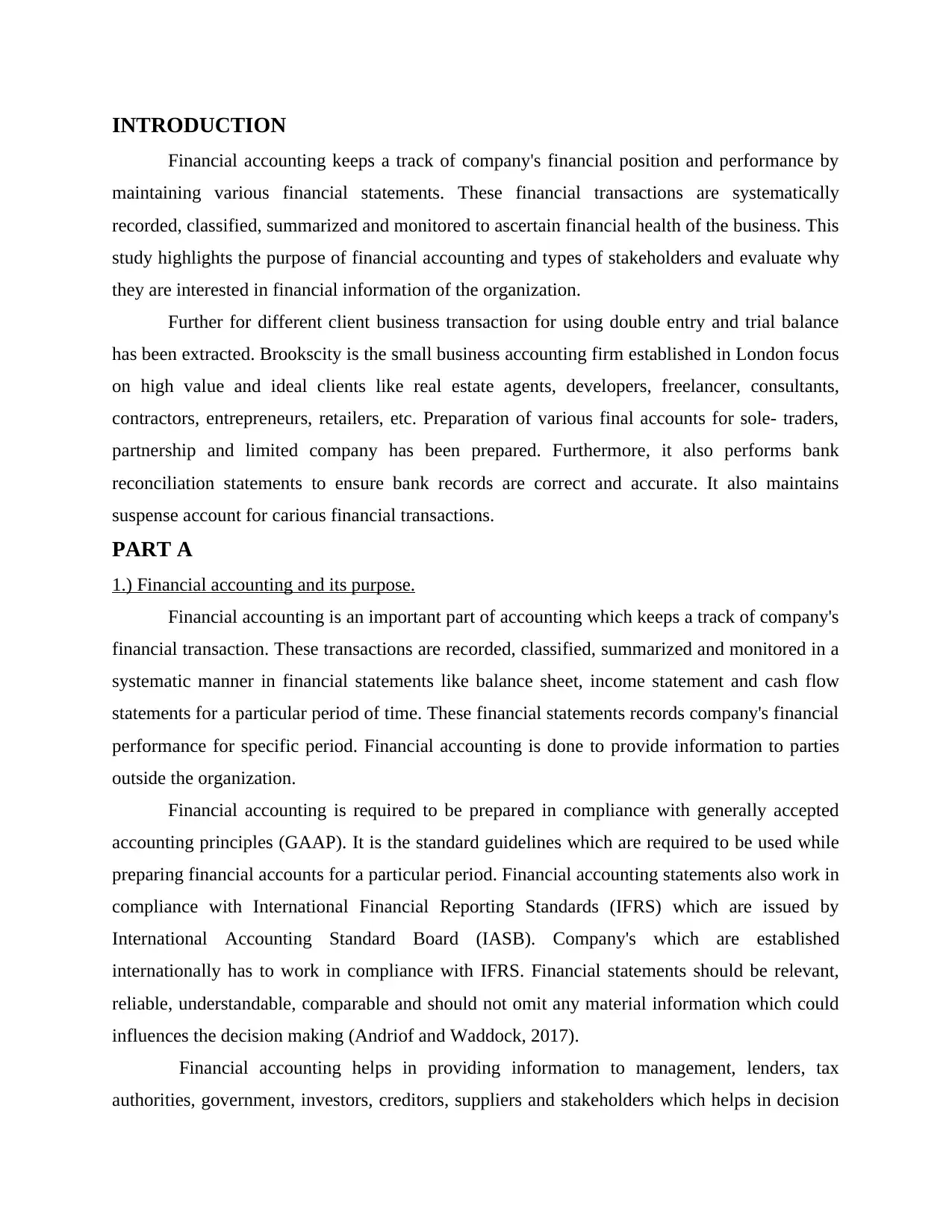
INTRODUCTION
Financial accounting keeps a track of company's financial position and performance by
maintaining various financial statements. These financial transactions are systematically
recorded, classified, summarized and monitored to ascertain financial health of the business. This
study highlights the purpose of financial accounting and types of stakeholders and evaluate why
they are interested in financial information of the organization.
Further for different client business transaction for using double entry and trial balance
has been extracted. Brookscity is the small business accounting firm established in London focus
on high value and ideal clients like real estate agents, developers, freelancer, consultants,
contractors, entrepreneurs, retailers, etc. Preparation of various final accounts for sole- traders,
partnership and limited company has been prepared. Furthermore, it also performs bank
reconciliation statements to ensure bank records are correct and accurate. It also maintains
suspense account for carious financial transactions.
PART A
1.) Financial accounting and its purpose.
Financial accounting is an important part of accounting which keeps a track of company's
financial transaction. These transactions are recorded, classified, summarized and monitored in a
systematic manner in financial statements like balance sheet, income statement and cash flow
statements for a particular period of time. These financial statements records company's financial
performance for specific period. Financial accounting is done to provide information to parties
outside the organization.
Financial accounting is required to be prepared in compliance with generally accepted
accounting principles (GAAP). It is the standard guidelines which are required to be used while
preparing financial accounts for a particular period. Financial accounting statements also work in
compliance with International Financial Reporting Standards (IFRS) which are issued by
International Accounting Standard Board (IASB). Company's which are established
internationally has to work in compliance with IFRS. Financial statements should be relevant,
reliable, understandable, comparable and should not omit any material information which could
influences the decision making (Andriof and Waddock, 2017).
Financial accounting helps in providing information to management, lenders, tax
authorities, government, investors, creditors, suppliers and stakeholders which helps in decision
Financial accounting keeps a track of company's financial position and performance by
maintaining various financial statements. These financial transactions are systematically
recorded, classified, summarized and monitored to ascertain financial health of the business. This
study highlights the purpose of financial accounting and types of stakeholders and evaluate why
they are interested in financial information of the organization.
Further for different client business transaction for using double entry and trial balance
has been extracted. Brookscity is the small business accounting firm established in London focus
on high value and ideal clients like real estate agents, developers, freelancer, consultants,
contractors, entrepreneurs, retailers, etc. Preparation of various final accounts for sole- traders,
partnership and limited company has been prepared. Furthermore, it also performs bank
reconciliation statements to ensure bank records are correct and accurate. It also maintains
suspense account for carious financial transactions.
PART A
1.) Financial accounting and its purpose.
Financial accounting is an important part of accounting which keeps a track of company's
financial transaction. These transactions are recorded, classified, summarized and monitored in a
systematic manner in financial statements like balance sheet, income statement and cash flow
statements for a particular period of time. These financial statements records company's financial
performance for specific period. Financial accounting is done to provide information to parties
outside the organization.
Financial accounting is required to be prepared in compliance with generally accepted
accounting principles (GAAP). It is the standard guidelines which are required to be used while
preparing financial accounts for a particular period. Financial accounting statements also work in
compliance with International Financial Reporting Standards (IFRS) which are issued by
International Accounting Standard Board (IASB). Company's which are established
internationally has to work in compliance with IFRS. Financial statements should be relevant,
reliable, understandable, comparable and should not omit any material information which could
influences the decision making (Andriof and Waddock, 2017).
Financial accounting helps in providing information to management, lenders, tax
authorities, government, investors, creditors, suppliers and stakeholders which helps in decision
⊘ This is a preview!⊘
Do you want full access?
Subscribe today to unlock all pages.

Trusted by 1+ million students worldwide
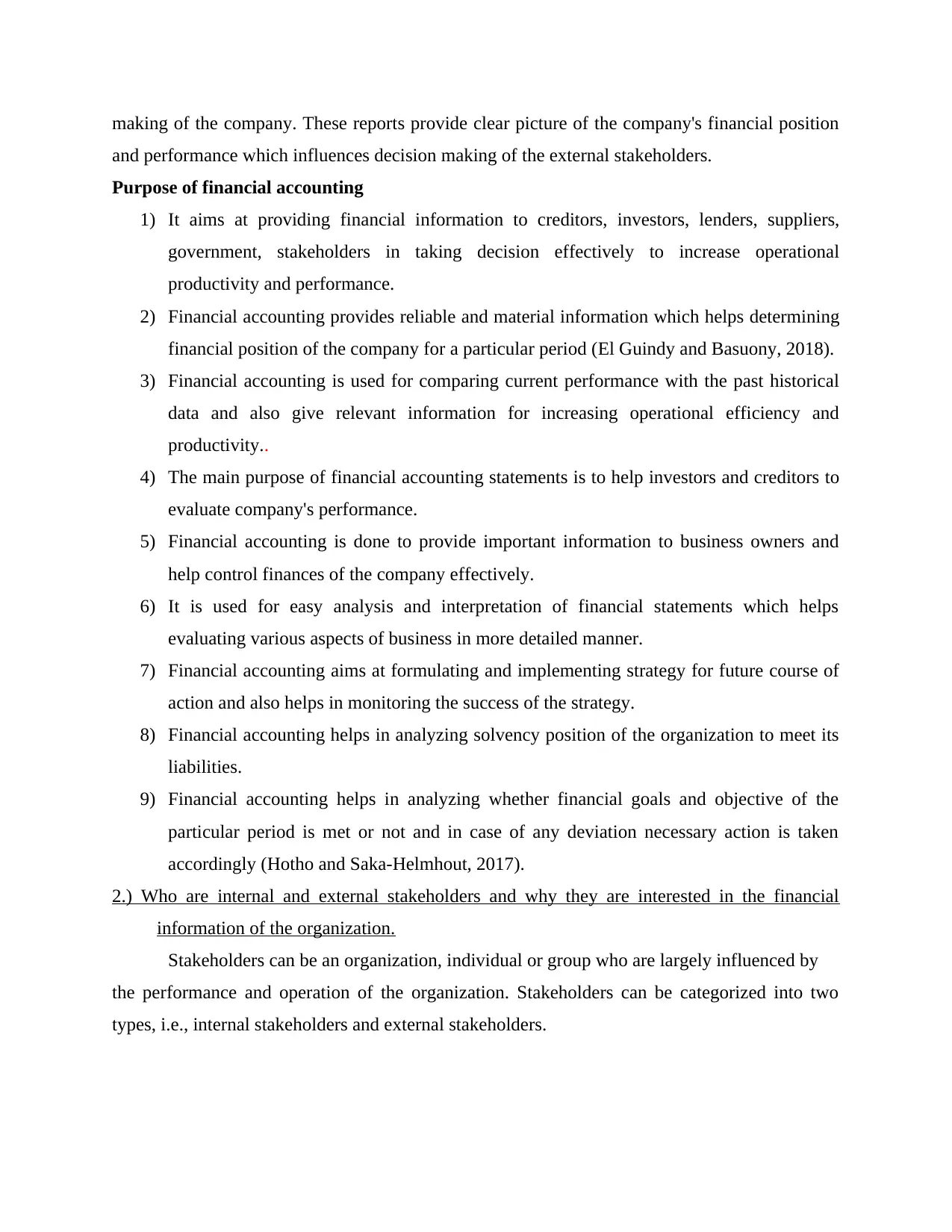
making of the company. These reports provide clear picture of the company's financial position
and performance which influences decision making of the external stakeholders.
Purpose of financial accounting
1) It aims at providing financial information to creditors, investors, lenders, suppliers,
government, stakeholders in taking decision effectively to increase operational
productivity and performance.
2) Financial accounting provides reliable and material information which helps determining
financial position of the company for a particular period (El Guindy and Basuony, 2018).
3) Financial accounting is used for comparing current performance with the past historical
data and also give relevant information for increasing operational efficiency and
productivity..
4) The main purpose of financial accounting statements is to help investors and creditors to
evaluate company's performance.
5) Financial accounting is done to provide important information to business owners and
help control finances of the company effectively.
6) It is used for easy analysis and interpretation of financial statements which helps
evaluating various aspects of business in more detailed manner.
7) Financial accounting aims at formulating and implementing strategy for future course of
action and also helps in monitoring the success of the strategy.
8) Financial accounting helps in analyzing solvency position of the organization to meet its
liabilities.
9) Financial accounting helps in analyzing whether financial goals and objective of the
particular period is met or not and in case of any deviation necessary action is taken
accordingly (Hotho and Saka-Helmhout, 2017).
2.) Who are internal and external stakeholders and why they are interested in the financial
information of the organization.
Stakeholders can be an organization, individual or group who are largely influenced by
the performance and operation of the organization. Stakeholders can be categorized into two
types, i.e., internal stakeholders and external stakeholders.
and performance which influences decision making of the external stakeholders.
Purpose of financial accounting
1) It aims at providing financial information to creditors, investors, lenders, suppliers,
government, stakeholders in taking decision effectively to increase operational
productivity and performance.
2) Financial accounting provides reliable and material information which helps determining
financial position of the company for a particular period (El Guindy and Basuony, 2018).
3) Financial accounting is used for comparing current performance with the past historical
data and also give relevant information for increasing operational efficiency and
productivity..
4) The main purpose of financial accounting statements is to help investors and creditors to
evaluate company's performance.
5) Financial accounting is done to provide important information to business owners and
help control finances of the company effectively.
6) It is used for easy analysis and interpretation of financial statements which helps
evaluating various aspects of business in more detailed manner.
7) Financial accounting aims at formulating and implementing strategy for future course of
action and also helps in monitoring the success of the strategy.
8) Financial accounting helps in analyzing solvency position of the organization to meet its
liabilities.
9) Financial accounting helps in analyzing whether financial goals and objective of the
particular period is met or not and in case of any deviation necessary action is taken
accordingly (Hotho and Saka-Helmhout, 2017).
2.) Who are internal and external stakeholders and why they are interested in the financial
information of the organization.
Stakeholders can be an organization, individual or group who are largely influenced by
the performance and operation of the organization. Stakeholders can be categorized into two
types, i.e., internal stakeholders and external stakeholders.
Paraphrase This Document
Need a fresh take? Get an instant paraphrase of this document with our AI Paraphraser
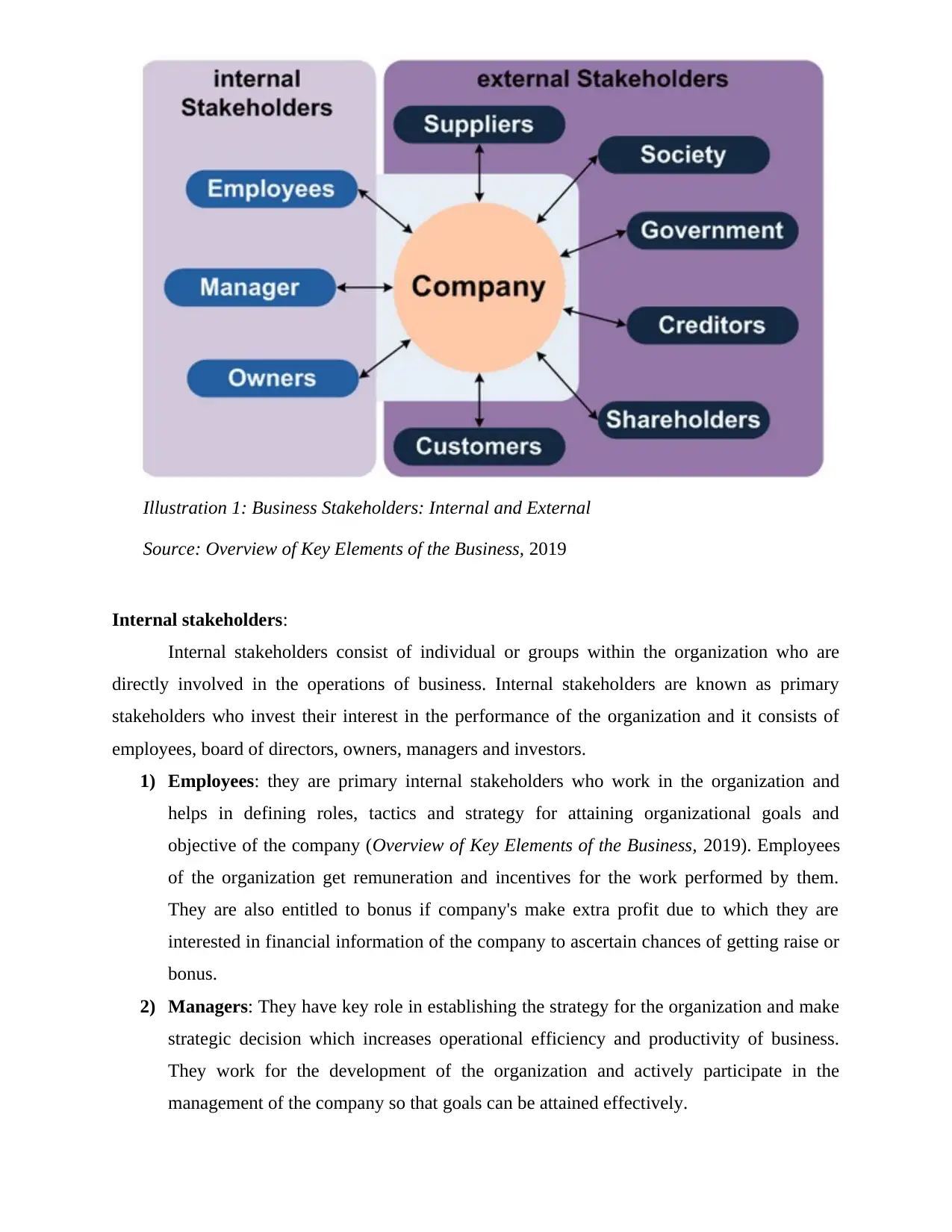
Internal stakeholders:
Internal stakeholders consist of individual or groups within the organization who are
directly involved in the operations of business. Internal stakeholders are known as primary
stakeholders who invest their interest in the performance of the organization and it consists of
employees, board of directors, owners, managers and investors.
1) Employees: they are primary internal stakeholders who work in the organization and
helps in defining roles, tactics and strategy for attaining organizational goals and
objective of the company (Overview of Key Elements of the Business, 2019). Employees
of the organization get remuneration and incentives for the work performed by them.
They are also entitled to bonus if company's make extra profit due to which they are
interested in financial information of the company to ascertain chances of getting raise or
bonus.
2) Managers: They have key role in establishing the strategy for the organization and make
strategic decision which increases operational efficiency and productivity of business.
They work for the development of the organization and actively participate in the
management of the company so that goals can be attained effectively.
Illustration 1: Business Stakeholders: Internal and External
Source: Overview of Key Elements of the Business, 2019
Internal stakeholders consist of individual or groups within the organization who are
directly involved in the operations of business. Internal stakeholders are known as primary
stakeholders who invest their interest in the performance of the organization and it consists of
employees, board of directors, owners, managers and investors.
1) Employees: they are primary internal stakeholders who work in the organization and
helps in defining roles, tactics and strategy for attaining organizational goals and
objective of the company (Overview of Key Elements of the Business, 2019). Employees
of the organization get remuneration and incentives for the work performed by them.
They are also entitled to bonus if company's make extra profit due to which they are
interested in financial information of the company to ascertain chances of getting raise or
bonus.
2) Managers: They have key role in establishing the strategy for the organization and make
strategic decision which increases operational efficiency and productivity of business.
They work for the development of the organization and actively participate in the
management of the company so that goals can be attained effectively.
Illustration 1: Business Stakeholders: Internal and External
Source: Overview of Key Elements of the Business, 2019
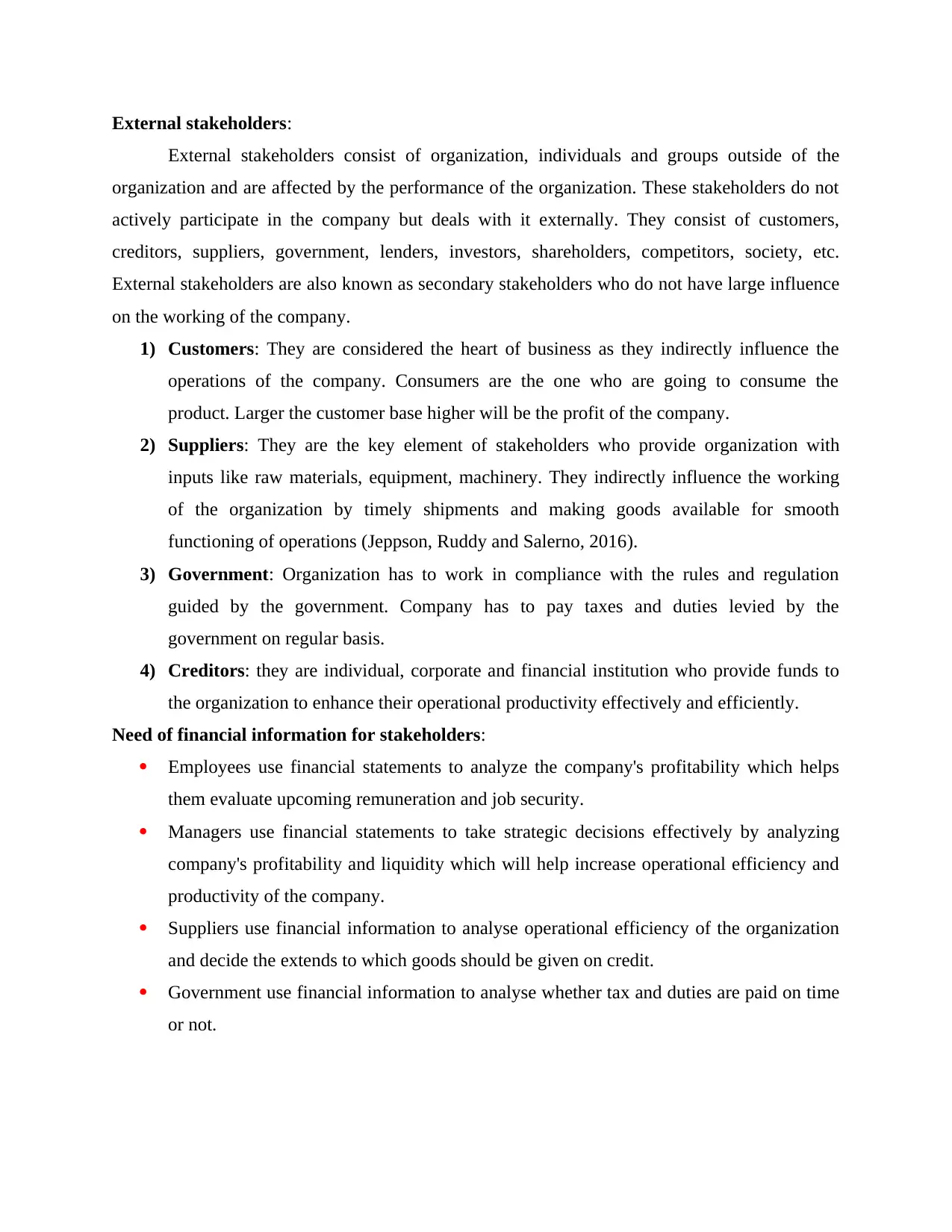
External stakeholders:
External stakeholders consist of organization, individuals and groups outside of the
organization and are affected by the performance of the organization. These stakeholders do not
actively participate in the company but deals with it externally. They consist of customers,
creditors, suppliers, government, lenders, investors, shareholders, competitors, society, etc.
External stakeholders are also known as secondary stakeholders who do not have large influence
on the working of the company.
1) Customers: They are considered the heart of business as they indirectly influence the
operations of the company. Consumers are the one who are going to consume the
product. Larger the customer base higher will be the profit of the company.
2) Suppliers: They are the key element of stakeholders who provide organization with
inputs like raw materials, equipment, machinery. They indirectly influence the working
of the organization by timely shipments and making goods available for smooth
functioning of operations (Jeppson, Ruddy and Salerno, 2016).
3) Government: Organization has to work in compliance with the rules and regulation
guided by the government. Company has to pay taxes and duties levied by the
government on regular basis.
4) Creditors: they are individual, corporate and financial institution who provide funds to
the organization to enhance their operational productivity effectively and efficiently.
Need of financial information for stakeholders:
Employees use financial statements to analyze the company's profitability which helps
them evaluate upcoming remuneration and job security.
Managers use financial statements to take strategic decisions effectively by analyzing
company's profitability and liquidity which will help increase operational efficiency and
productivity of the company.
Suppliers use financial information to analyse operational efficiency of the organization
and decide the extends to which goods should be given on credit.
Government use financial information to analyse whether tax and duties are paid on time
or not.
External stakeholders consist of organization, individuals and groups outside of the
organization and are affected by the performance of the organization. These stakeholders do not
actively participate in the company but deals with it externally. They consist of customers,
creditors, suppliers, government, lenders, investors, shareholders, competitors, society, etc.
External stakeholders are also known as secondary stakeholders who do not have large influence
on the working of the company.
1) Customers: They are considered the heart of business as they indirectly influence the
operations of the company. Consumers are the one who are going to consume the
product. Larger the customer base higher will be the profit of the company.
2) Suppliers: They are the key element of stakeholders who provide organization with
inputs like raw materials, equipment, machinery. They indirectly influence the working
of the organization by timely shipments and making goods available for smooth
functioning of operations (Jeppson, Ruddy and Salerno, 2016).
3) Government: Organization has to work in compliance with the rules and regulation
guided by the government. Company has to pay taxes and duties levied by the
government on regular basis.
4) Creditors: they are individual, corporate and financial institution who provide funds to
the organization to enhance their operational productivity effectively and efficiently.
Need of financial information for stakeholders:
Employees use financial statements to analyze the company's profitability which helps
them evaluate upcoming remuneration and job security.
Managers use financial statements to take strategic decisions effectively by analyzing
company's profitability and liquidity which will help increase operational efficiency and
productivity of the company.
Suppliers use financial information to analyse operational efficiency of the organization
and decide the extends to which goods should be given on credit.
Government use financial information to analyse whether tax and duties are paid on time
or not.
⊘ This is a preview!⊘
Do you want full access?
Subscribe today to unlock all pages.

Trusted by 1+ million students worldwide
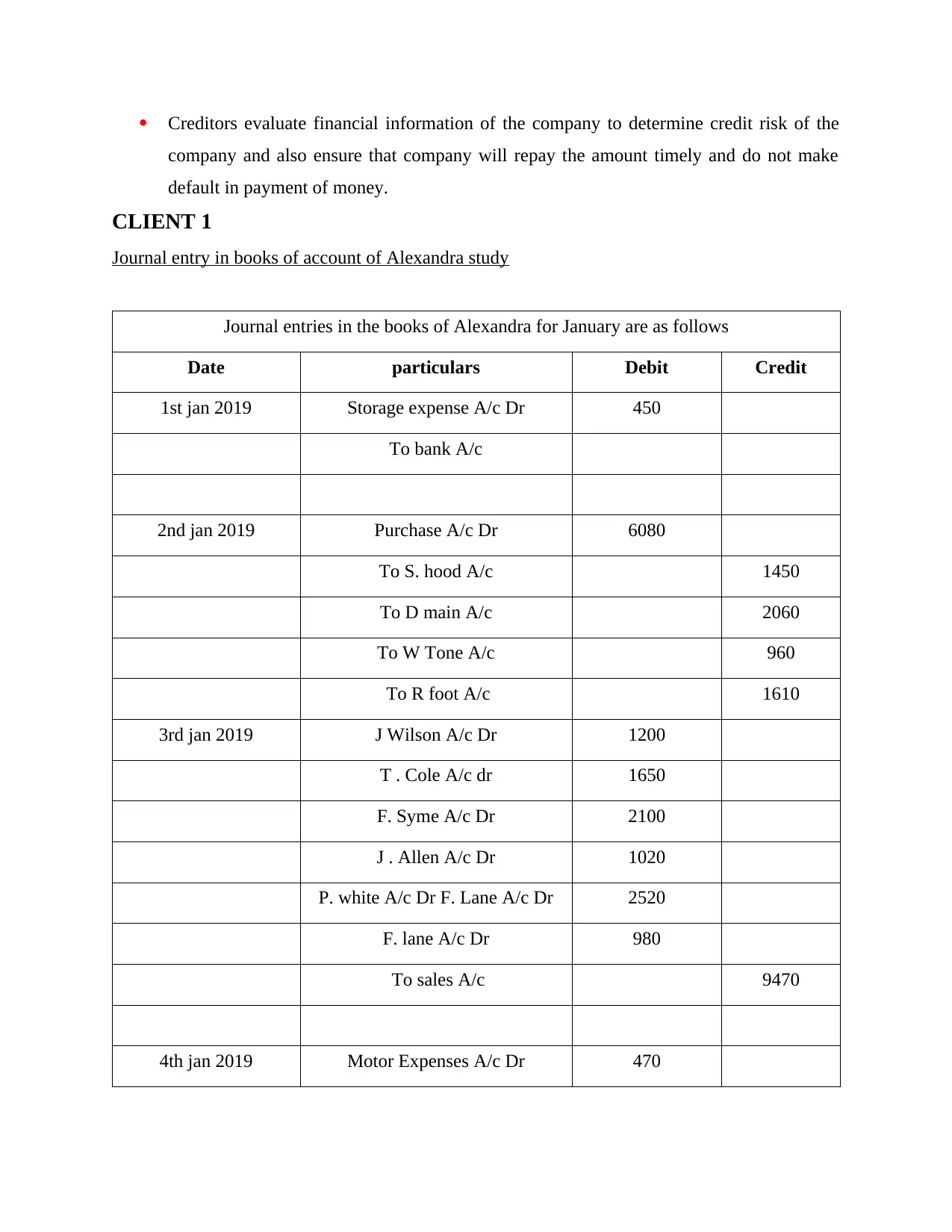
Creditors evaluate financial information of the company to determine credit risk of the
company and also ensure that company will repay the amount timely and do not make
default in payment of money.
CLIENT 1
Journal entry in books of account of Alexandra study
Journal entries in the books of Alexandra for January are as follows
Date particulars Debit Credit
1st jan 2019 Storage expense A/c Dr 450
To bank A/c
2nd jan 2019 Purchase A/c Dr 6080
To S. hood A/c 1450
To D main A/c 2060
To W Tone A/c 960
To R foot A/c 1610
3rd jan 2019 J Wilson A/c Dr 1200
T . Cole A/c dr 1650
F. Syme A/c Dr 2100
J . Allen A/c Dr 1020
P. white A/c Dr F. Lane A/c Dr 2520
F. lane A/c Dr 980
To sales A/c 9470
4th jan 2019 Motor Expenses A/c Dr 470
company and also ensure that company will repay the amount timely and do not make
default in payment of money.
CLIENT 1
Journal entry in books of account of Alexandra study
Journal entries in the books of Alexandra for January are as follows
Date particulars Debit Credit
1st jan 2019 Storage expense A/c Dr 450
To bank A/c
2nd jan 2019 Purchase A/c Dr 6080
To S. hood A/c 1450
To D main A/c 2060
To W Tone A/c 960
To R foot A/c 1610
3rd jan 2019 J Wilson A/c Dr 1200
T . Cole A/c dr 1650
F. Syme A/c Dr 2100
J . Allen A/c Dr 1020
P. white A/c Dr F. Lane A/c Dr 2520
F. lane A/c Dr 980
To sales A/c 9470
4th jan 2019 Motor Expenses A/c Dr 470
Paraphrase This Document
Need a fresh take? Get an instant paraphrase of this document with our AI Paraphraser
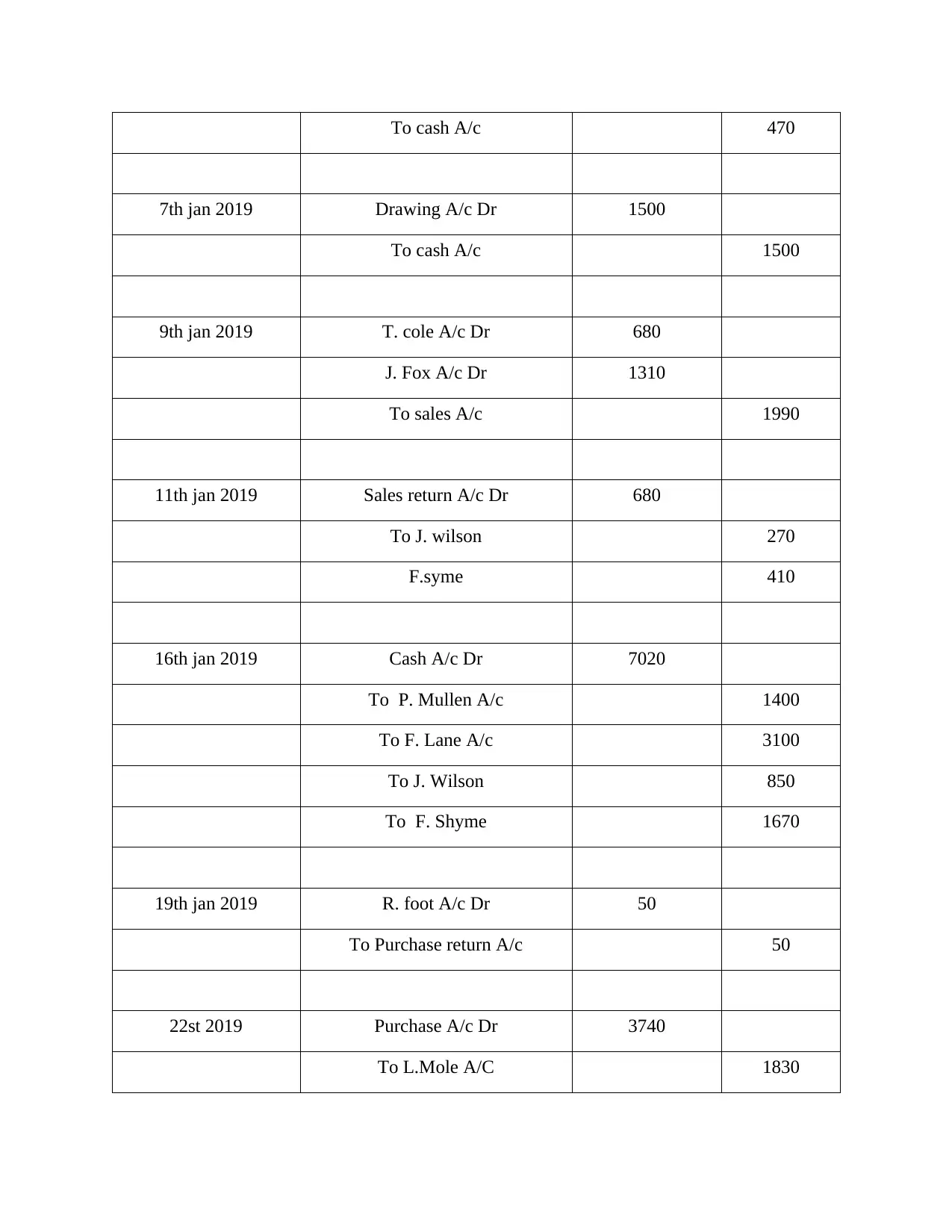
To cash A/c 470
7th jan 2019 Drawing A/c Dr 1500
To cash A/c 1500
9th jan 2019 T. cole A/c Dr 680
J. Fox A/c Dr 1310
To sales A/c 1990
11th jan 2019 Sales return A/c Dr 680
To J. wilson 270
F.syme 410
16th jan 2019 Cash A/c Dr 7020
To P. Mullen A/c 1400
To F. Lane A/c 3100
To J. Wilson 850
To F. Shyme 1670
19th jan 2019 R. foot A/c Dr 50
To Purchase return A/c 50
22st 2019 Purchase A/c Dr 3740
To L.Mole A/C 1830
7th jan 2019 Drawing A/c Dr 1500
To cash A/c 1500
9th jan 2019 T. cole A/c Dr 680
J. Fox A/c Dr 1310
To sales A/c 1990
11th jan 2019 Sales return A/c Dr 680
To J. wilson 270
F.syme 410
16th jan 2019 Cash A/c Dr 7020
To P. Mullen A/c 1400
To F. Lane A/c 3100
To J. Wilson 850
To F. Shyme 1670
19th jan 2019 R. foot A/c Dr 50
To Purchase return A/c 50
22st 2019 Purchase A/c Dr 3740
To L.Mole A/C 1830
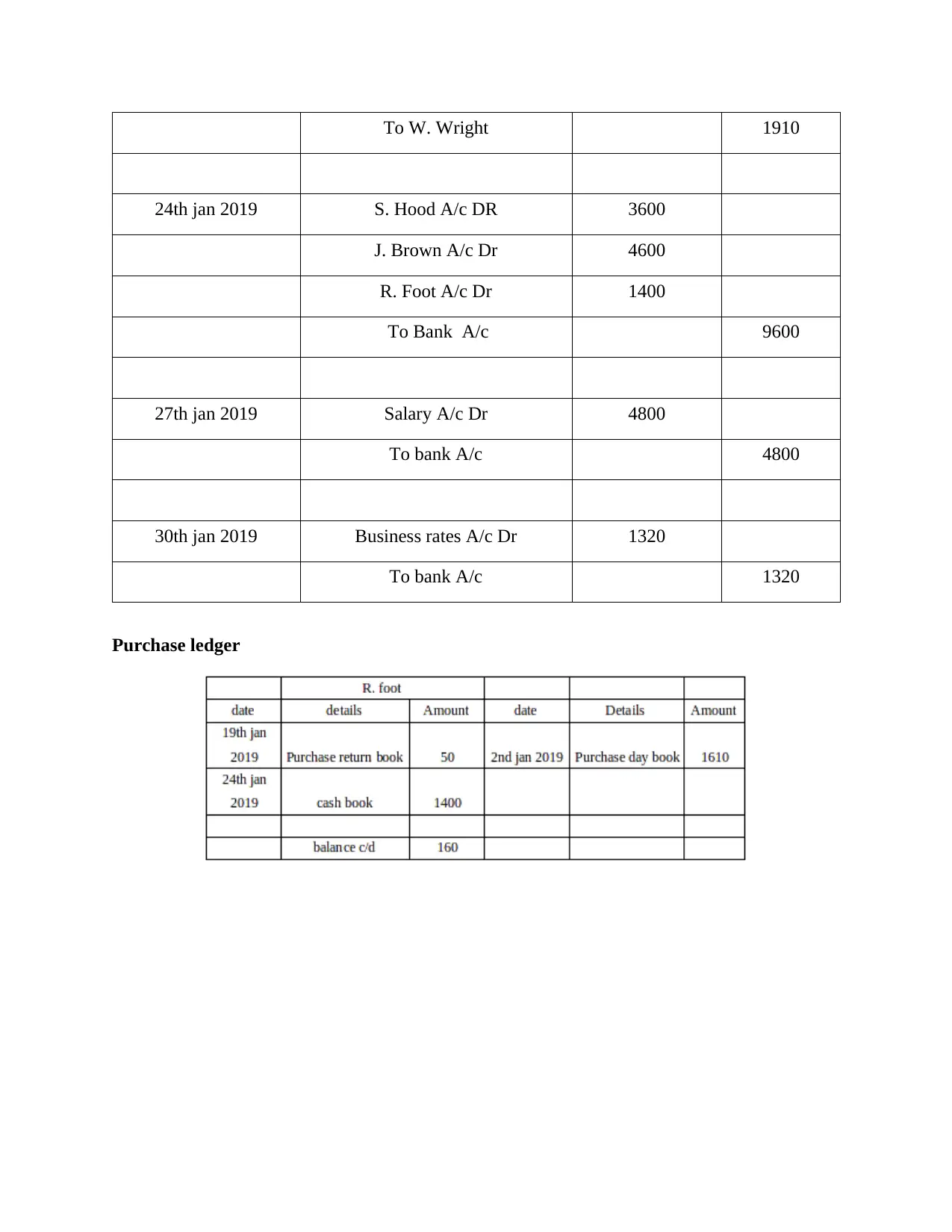
To W. Wright 1910
24th jan 2019 S. Hood A/c DR 3600
J. Brown A/c Dr 4600
R. Foot A/c Dr 1400
To Bank A/c 9600
27th jan 2019 Salary A/c Dr 4800
To bank A/c 4800
30th jan 2019 Business rates A/c Dr 1320
To bank A/c 1320
Purchase ledger
24th jan 2019 S. Hood A/c DR 3600
J. Brown A/c Dr 4600
R. Foot A/c Dr 1400
To Bank A/c 9600
27th jan 2019 Salary A/c Dr 4800
To bank A/c 4800
30th jan 2019 Business rates A/c Dr 1320
To bank A/c 1320
Purchase ledger
⊘ This is a preview!⊘
Do you want full access?
Subscribe today to unlock all pages.

Trusted by 1+ million students worldwide
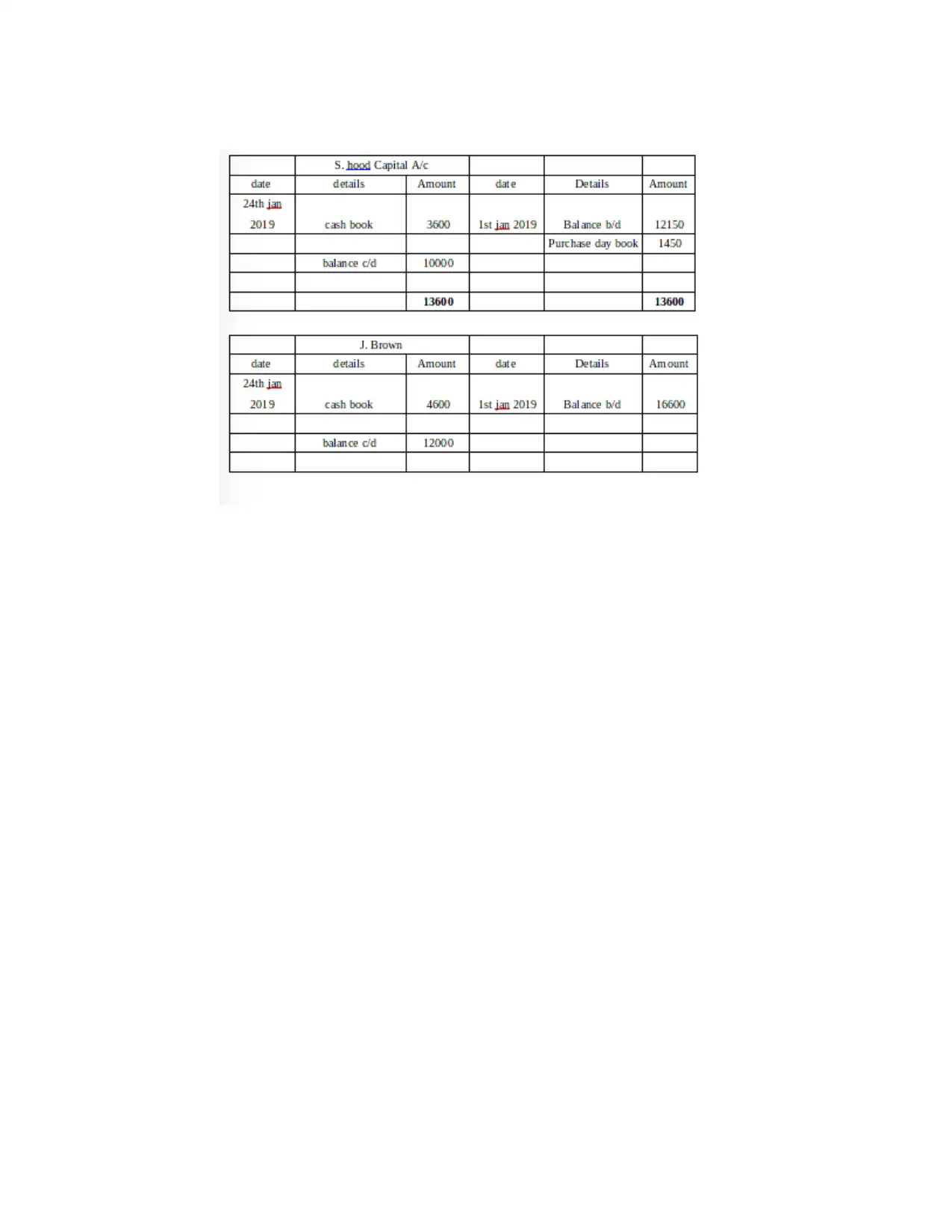
Paraphrase This Document
Need a fresh take? Get an instant paraphrase of this document with our AI Paraphraser
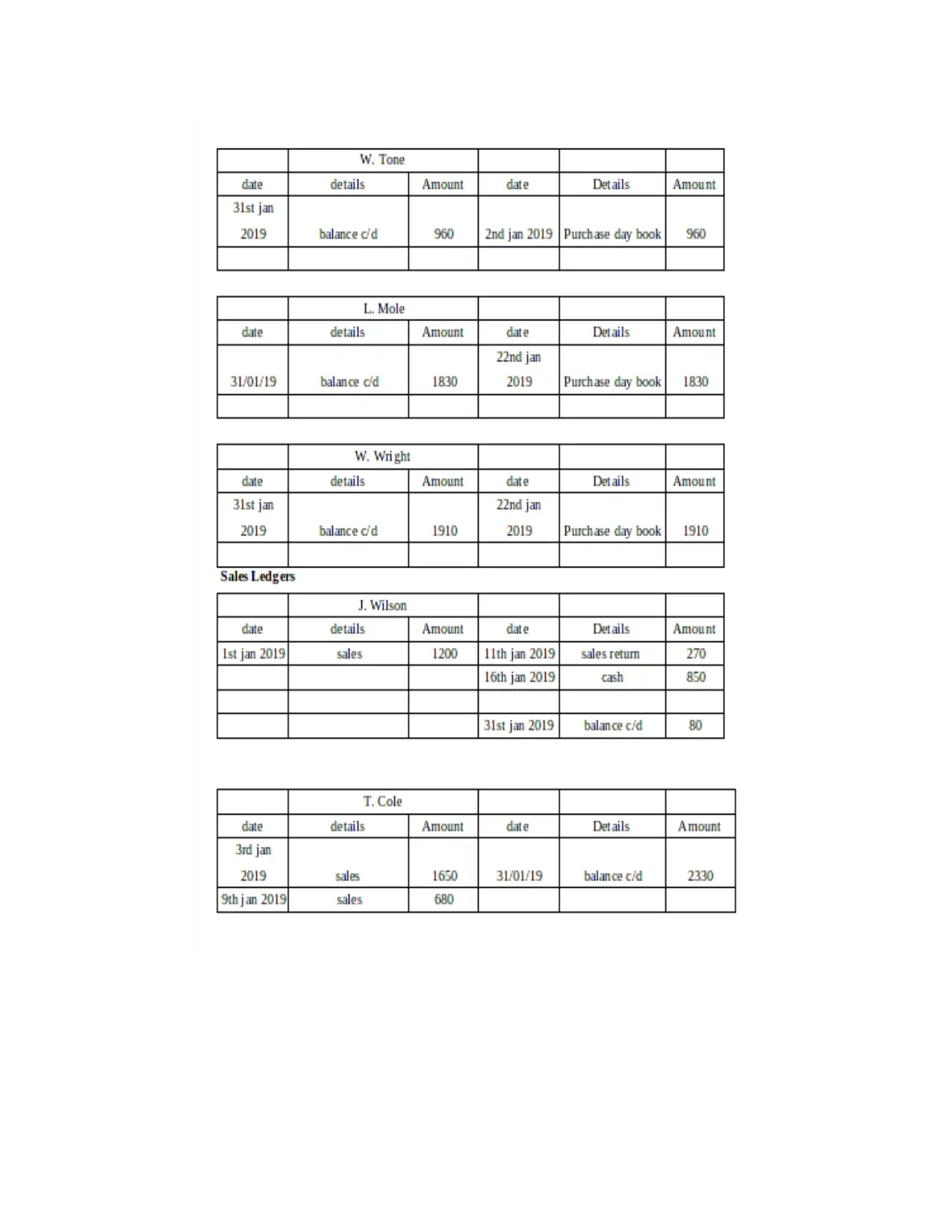
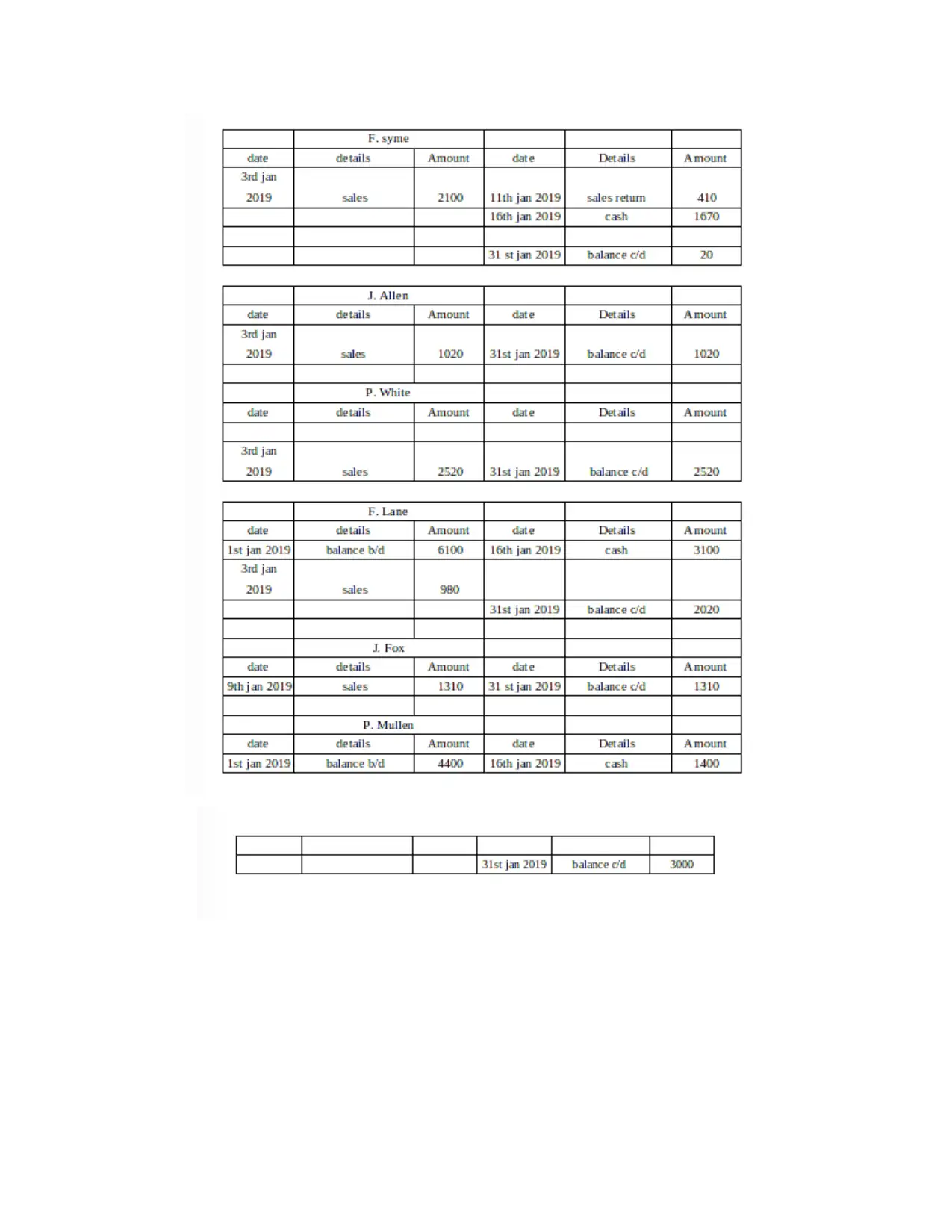
⊘ This is a preview!⊘
Do you want full access?
Subscribe today to unlock all pages.

Trusted by 1+ million students worldwide
1 out of 26
Related Documents
Your All-in-One AI-Powered Toolkit for Academic Success.
+13062052269
info@desklib.com
Available 24*7 on WhatsApp / Email
![[object Object]](/_next/static/media/star-bottom.7253800d.svg)
Unlock your academic potential
Copyright © 2020–2025 A2Z Services. All Rights Reserved. Developed and managed by ZUCOL.





